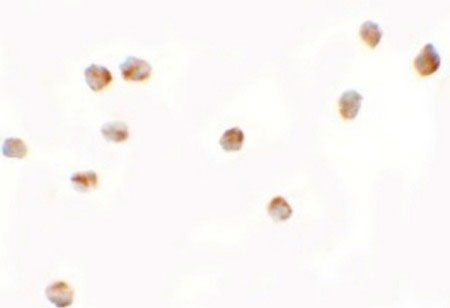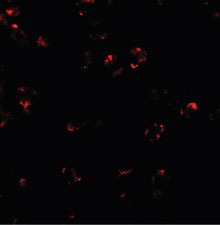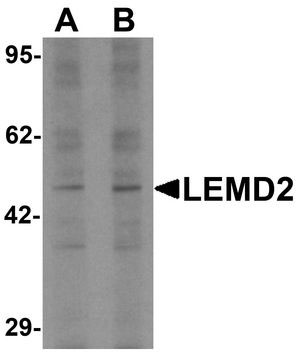LEMD2 Antibody (Internal)
Rabbit Polyclonal Antibody
- SPECIFICATION
- CITATIONS
- PROTOCOLS
- BACKGROUND

Application
| WB, IHC-P, IF, ICC |
|---|---|
| Primary Accession | Q8NC56 |
| Reactivity | Human |
| Host | Rabbit |
| Clonality | Polyclonal |
| Calculated MW | 57kDa |
| Dilution | IHC-P (5 µg/ml), WB (1-2 µg/ml), |
| Gene ID | 221496 |
|---|---|
| Other Names | LEM domain-containing protein 2, hLEM2, LEMD2 |
| Target/Specificity | Human LEMD2. At least two isoforms of LEMD2 are known to exist; this antibody will detect only the longer isoform. |
| Reconstitution & Storage | Store at -20°C. Aliquot to avoid freeze/thaw cycles. |
| Precautions | LEMD2 Antibody (Internal) is for research use only and not for use in diagnostic or therapeutic procedures. |
| Name | LEMD2 |
|---|---|
| Function | Nuclear lamina-associated inner nuclear membrane protein that is involved in nuclear structure organization, maintenance of nuclear envelope (NE) integrity and NE reformation after mitosis (PubMed:16339967, PubMed:17097643, PubMed:28242692, PubMed:32494070). Plays a role as transmembrane adapter for the endosomal sorting complexes required for transport (ESCRT), and is thereby involved in ESCRT-mediated NE reformation (PubMed:28242692, PubMed:32494070). Promotes ESCRT-mediated NE closure by recruiting CHMP7 and downstream ESCRT-III proteins IST1/CHMP8 and CHMP2A to the reforming NE during anaphase (PubMed:28242692). During nuclear reassembly, condenses into a liquid-like coating around microtubule spindles and coassembles with CHMP7 to form a macromolecular O-ring seal at the confluence between membranes, chromatin, and the spindle to facilitate early nuclear sealing (PubMed:32494070). Plays a role in the organization of heterochromatin associated with the NE and in the maintenance of NE organization under mechanical stress (By similarity). Required for embryonic development and involved in regulation of several signaling pathways such as MAPK and AKT (By similarity). Required for myoblast differentiation involving regulation of ERK signaling (By similarity). Essential for cardiac homeostasis and proper heart function (By similarity). |
| Cellular Location | Nucleus inner membrane; Multi-pass membrane protein. Nucleus envelope. Cytoplasm, cytoskeleton, spindle. Note=Lamina-associated protein residing in the inner nuclear membrane (INM) of the nuclear envelope (NE) (PubMed:16339967). The localization to the INM is dependent on LMNA (PubMed:16339967). Evenly distributed around the NE during interphase (PubMed:16339967). During metaphase, found in a reticular network (PubMed:28242692). Recruited to the reforming NE on chromatin disks in early anaphase (PubMed:28242692). In late anaphase, concentrates at the NE core proximal to spindle microtubules, and then broadening to a distributed nuclear rim pattern (PubMed:28242692, PubMed:32494070) |
| Tissue Location | Ubiquitously expressed, including bone marrow, brain, kidney, colon, skeletal muscle, thymus, testis and uterus |

Thousands of laboratories across the world have published research that depended on the performance of antibodies from Abcepta to advance their research. Check out links to articles that cite our products in major peer-reviewed journals, organized by research category.
info@abcepta.com, and receive a free "I Love Antibodies" mug.
Provided below are standard protocols that you may find useful for product applications.
Background
Involved in nuclear structure organization.
References
Ota T.,et al.Nat. Genet. 36:40-45(2004).
Otsuki T.,et al.DNA Res. 12:117-126(2005).
Mungall A.J.,et al.Nature 425:805-811(2003).
Brachner A.,et al.J. Cell Sci. 118:5797-5810(2005).
Olsen J.V.,et al.Cell 127:635-648(2006).
If you have used an Abcepta product and would like to share how it has performed, please click on the "Submit Review" button and provide the requested information. Our staff will examine and post your review and contact you if needed.
If you have any additional inquiries please email technical services at tech@abcepta.com.













 Foundational characteristics of cancer include proliferation, angiogenesis, migration, evasion of apoptosis, and cellular immortality. Find key markers for these cellular processes and antibodies to detect them.
Foundational characteristics of cancer include proliferation, angiogenesis, migration, evasion of apoptosis, and cellular immortality. Find key markers for these cellular processes and antibodies to detect them. The SUMOplot™ Analysis Program predicts and scores sumoylation sites in your protein. SUMOylation is a post-translational modification involved in various cellular processes, such as nuclear-cytosolic transport, transcriptional regulation, apoptosis, protein stability, response to stress, and progression through the cell cycle.
The SUMOplot™ Analysis Program predicts and scores sumoylation sites in your protein. SUMOylation is a post-translational modification involved in various cellular processes, such as nuclear-cytosolic transport, transcriptional regulation, apoptosis, protein stability, response to stress, and progression through the cell cycle. The Autophagy Receptor Motif Plotter predicts and scores autophagy receptor binding sites in your protein. Identifying proteins connected to this pathway is critical to understanding the role of autophagy in physiological as well as pathological processes such as development, differentiation, neurodegenerative diseases, stress, infection, and cancer.
The Autophagy Receptor Motif Plotter predicts and scores autophagy receptor binding sites in your protein. Identifying proteins connected to this pathway is critical to understanding the role of autophagy in physiological as well as pathological processes such as development, differentiation, neurodegenerative diseases, stress, infection, and cancer.




